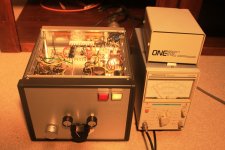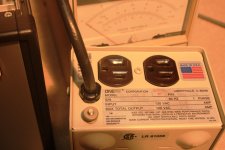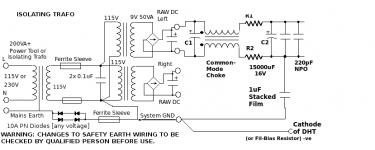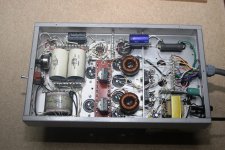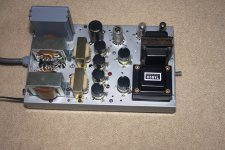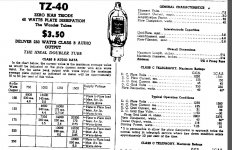You could also try biasing through an input transformer, thus eliminating the coupling cap without putting a resistor in the cathode. This has the added advantage of a very low resistance to ground for the grid, like a grid choke would provide. It sounds much better to me than grid bias with a cap. I talked about it back in post #2228 of this thread:
http://www.diyaudio.com/forums/tubes-valves/151421-26-pre-amp-223.html#post3259342
One thing I learned is that the output impedance of your source is important to get right in this arrangement in order to get the best squarewave performance. I found that a total of 1000ohms worked best with the input transformer set up as I have it (LL1676, 2||2:1||1, 2nF+850ohm snubber on secondary) so I added 800ohms to the primary, since my source has a 200ohm Zout. Here's a link to the scope shots:
http://www.diyaudio.com/forums/tube...-input-transformer-overshoot.html#post3286198
http://www.diyaudio.com/forums/tubes-valves/151421-26-pre-amp-223.html#post3259342
One thing I learned is that the output impedance of your source is important to get right in this arrangement in order to get the best squarewave performance. I found that a total of 1000ohms worked best with the input transformer set up as I have it (LL1676, 2||2:1||1, 2nF+850ohm snubber on secondary) so I added 800ohms to the primary, since my source has a 200ohm Zout. Here's a link to the scope shots:
http://www.diyaudio.com/forums/tube...-input-transformer-overshoot.html#post3286198
Rod, I am sorry, afore-mentioned residual noise level 0.31mV was incorrect!
It was 0.031mV.
Result of your check list:
1) 0.5mV~8mV(at the peak)
2) 0.5mV~5mV(peak)
3) 0.12mV Filament to Firament:0.03mV
4) Capacitance from primary to secondary:?
Filament transformer constraction:E-I core
Install an isolating transformer
4) Fitted 2200 mF
5) Not yet fitted
After installed 2200 mF and isolating transformer, the residual noise is improved to 0.025mV.
It was 0.031mV.
Result of your check list:
1) 0.5mV~8mV(at the peak)
2) 0.5mV~5mV(peak)
3) 0.12mV Filament to Firament:0.03mV
4) Capacitance from primary to secondary:?
Filament transformer constraction:E-I core
Install an isolating transformer
4) Fitted 2200 mF
5) Not yet fitted
After installed 2200 mF and isolating transformer, the residual noise is improved to 0.025mV.
Attachments
Hiro, The measurements look very good to me.
Possibly, the common-mode noise voltage can be reduced a little more. It is difficult to improve on 25uV - but maybe this voltage is caused by some leakage current from primary to secondary of the filament transformer. The isolating transformer is very helpful, but perhaps a common-mode filter can be considered.
The drawing shows some ideas for common-mode filtering. You already have the isolating transformer, and excellent differential-mode filtering, so the common-mode choke (Murata) + capacitor is another option.
Murata choke:
52106C | Common Mode Chokes | Magnetics | Products | Murata Power Solutions
Possibly, the common-mode noise voltage can be reduced a little more. It is difficult to improve on 25uV - but maybe this voltage is caused by some leakage current from primary to secondary of the filament transformer. The isolating transformer is very helpful, but perhaps a common-mode filter can be considered.
The drawing shows some ideas for common-mode filtering. You already have the isolating transformer, and excellent differential-mode filtering, so the common-mode choke (Murata) + capacitor is another option.
Murata choke:
52106C | Common Mode Chokes | Magnetics | Products | Murata Power Solutions
Attachments
I finished building a test circuit this weekend of a 26 parafeed headphone amp for my Sony 7506's (60 ohm). To my relief it is dead quiet. It's a take off of kevinkr's design using Rod's filament board, tomchr's maida reg, and K&K ccs (maybe I should put a diyAudio emblem on the front). It was a good way of weeding out the duds and sputzers in my 12 year old collection and it would be nice to have a completely unnecessary headphone amplifier using 80 year old active devices.
The problem I'm faced with is the output tranny is not optimal and is heading to another project anyway (MQ EXO-45). I tried using a 120V:7V 5VA toroid for the parafeed trafo and it doesn't work at all in this situation. I'm now looking for a suitable headphone/signal level parafeed (no gap) transformer to use and Lundahl is too much for what I want to put in to the project. I was thinking this Edcor might be what I'm looking for but I'm not sure. Anyone know if it is suitable?
The problem I'm faced with is the output tranny is not optimal and is heading to another project anyway (MQ EXO-45). I tried using a 120V:7V 5VA toroid for the parafeed trafo and it doesn't work at all in this situation. I'm now looking for a suitable headphone/signal level parafeed (no gap) transformer to use and Lundahl is too much for what I want to put in to the project. I was thinking this Edcor might be what I'm looking for but I'm not sure. Anyone know if it is suitable?
Rod,Hiro, The measurements look very good to me.
Possibly, the common-mode noise voltage can be reduced a little more. It is difficult to improve on 25uV - but maybe this voltage is caused by some leakage current from primary to secondary of the filament transformer. The isolating transformer is very helpful, but perhaps a common-mode filter can be considered.
The drawing shows some ideas for common-mode filtering. You already have the isolating transformer, and excellent differential-mode filtering, so the common-mode choke (Murata) + capacitor is another option.
Murata choke:
52106C | Common Mode Chokes | Magnetics | Products | Murata Power Solutions
Thank you for your advice.
I tried fitted comon-mode choke in my stock , but the result was getting worse.
It is difficult to reduce the noise from this level.
As you mentioned, the isolating transformer is quite effective.
Best regards
Hiro
Attachments
tcqanh,
I`d like 26pre rather than 71a.
Although 71a was a capacitor cuppling with normal biasing.
I will try 71a with fillament bias later.
Regards
Hiro
I did build RCA 71A pre amp with plate choke and fixed bias. Its sound is really attractive for Single end fan like me. I have also RCA 26 pair. Looking the plate shape, they are nearly the same. I cannot distinguish them from others. So I think their sound are much similar.
Hopping you will try 71A with filament bias in the same circuit in someday.
Last edited:
I did build RCA 71A pre amp with plate choke and fixed bias. Its sound is really attractive for Single end fan like me. I have also RCA 26 pair. Looking the plate shape, they are nearly the same. I cannot distinguish them from others. So I think their sound are much similar.
Hopping you will try 71A with filament bias in the same circuit in someday.
Have you compared the sound impression between 71A and 26?

Teqanh and tyo94,
First of all, my 26 pre has been remodeled from 71a.
I will try again 71a with filament bias in someday.
71a and 26 looks to be similar at glace, but 71a is originaly designed for power tube use meanwhile 26 is for voltage amplifier use. I feel 71a was not so exciting as center of the sound shifted to lower range, while 26 is well balanced in all sound ranges, higher in clarity and transparency.
First of all, my 26 pre has been remodeled from 71a.
I will try again 71a with filament bias in someday.
71a and 26 looks to be similar at glace, but 71a is originaly designed for power tube use meanwhile 26 is for voltage amplifier use. I feel 71a was not so exciting as center of the sound shifted to lower range, while 26 is well balanced in all sound ranges, higher in clarity and transparency.
Hi Hiro-san,
I am sorry if there's misunderstanding caused by my question. Actually my question is addressed to tcqanh. I have curiosity about differences about 71A and 26 tubes, if he do comparison between both tubes yet. Anyway, thanks to you for explaining that.
Actually, there's no reason that for tube cannot be used for preamp. Thomas Mayer's project based on 10Y tube for his preamp. I had my friend also using power tube (RS241) for preamp. I don't know about the sound impression of 10Y as preamp, but RS241 based preamp feels so impressive (at least for me). The sound stage, clarity, transparency and detail are superb.
Anyway, is there any info for good DHT tube beside 26 which can be used for good DHT preamp?
I am sorry if there's misunderstanding caused by my question. Actually my question is addressed to tcqanh. I have curiosity about differences about 71A and 26 tubes, if he do comparison between both tubes yet. Anyway, thanks to you for explaining that.
Actually, there's no reason that for tube cannot be used for preamp. Thomas Mayer's project based on 10Y tube for his preamp. I had my friend also using power tube (RS241) for preamp. I don't know about the sound impression of 10Y as preamp, but RS241 based preamp feels so impressive (at least for me). The sound stage, clarity, transparency and detail are superb.
Anyway, is there any info for good DHT tube beside 26 which can be used for good DHT preamp?
Hi!
It is always important to look at it from the entire system. What is needed from the preamp. Gain? Low output impedance or both. Depending on that the tube chocie can be done.
My favorite for linestages is the 10Y / 801A family of tubes. I don't need much gain in a linestage so I can use these with step down to get low output impedance as an ideal driver for a TVC.
Other candidates besides the 26 would be the UX112 or if you want somewhat euphonic sound the UX201A. You could even use large triodes like the 211 or 845 if you are prepared to deal with them.
But again don't look at the tube alone. In my opinion the volume control is at least as important as the tube.
And of course many other possible choices
Best regards
Thomas
Anyway, is there any info for good DHT tube beside 26 which can be used for good DHT preamp?
It is always important to look at it from the entire system. What is needed from the preamp. Gain? Low output impedance or both. Depending on that the tube chocie can be done.
My favorite for linestages is the 10Y / 801A family of tubes. I don't need much gain in a linestage so I can use these with step down to get low output impedance as an ideal driver for a TVC.
Other candidates besides the 26 would be the UX112 or if you want somewhat euphonic sound the UX201A. You could even use large triodes like the 211 or 845 if you are prepared to deal with them.
But again don't look at the tube alone. In my opinion the volume control is at least as important as the tube.
And of course many other possible choices
Best regards
Thomas
Last edited:
My favorite for linestages is the 10Y / 801A family of tubes. I don't need much gain in a linestage so I can use these with step down to get low output impedance as an ideal driver for a TVC.
Same with me, I don't need much gain. Currently, I do experiment by building preamp based on RE144 (gain: 10). I haven't try 26 yet, even though I already have the tubes. Some people said that this tube hard to handle when it comes to filament.
But again don't look at the tube alone. In my opinion the volume control is at least as important as the tube.
Why the volume control has the same importance as the tube? Is there any specific reason? I am sorry for my silly question. I am really newbie in DHT Triode world.
Anyway, is there any info for good DHT tube beside 26 which can be used for good DHT preamp?>>
I've tried most DHTs. My favourite is the 4P1L in filament bias into a LL1660/18mA. This replaced my 26 preamp which replaced my 10Y preamp which replaced my 01A preamp which replaced my 1G4G preamp (nice tube, VERY microphonic).
I'm so pleased with the 4P1L I haven't used anything else for about half a year now, and usually tubes go in and out of fashion with me. But the 4P1L is a keeper.
71A, 112A, 46 and several others fell by the wayside. I do respect the 46 a lot but it demands more in filament bias than I'm willing to give it!
I've tried most DHTs. My favourite is the 4P1L in filament bias into a LL1660/18mA. This replaced my 26 preamp which replaced my 10Y preamp which replaced my 01A preamp which replaced my 1G4G preamp (nice tube, VERY microphonic).
I'm so pleased with the 4P1L I haven't used anything else for about half a year now, and usually tubes go in and out of fashion with me. But the 4P1L is a keeper.
71A, 112A, 46 and several others fell by the wayside. I do respect the 46 a lot but it demands more in filament bias than I'm willing to give it!
I like the 4P1L, CX301a as well as 46 and 10Y. The latter two are quite demanding for filament bias, so not ideal if you're not willing to invest in the filament supply. I;m currently using the 46 in filament bias as a driver and the filament supply is simply: big!
The 4P1L can be a great poor man's DHT preamp valve. You can get excellent results with a mu-follower gyrator load circuit. Many have implemented this preamp with great results but if you can go for a LL1660/20mA you can achieve a very low output impedance without the compromise of the output capacitor. But then, the budget is different. The other advantage of the gyrator load is the PSRR.
I personally like the tone of the 01a and I'm running it with a gyrator load as well.
Ale
The 4P1L can be a great poor man's DHT preamp valve. You can get excellent results with a mu-follower gyrator load circuit. Many have implemented this preamp with great results but if you can go for a LL1660/20mA you can achieve a very low output impedance without the compromise of the output capacitor. But then, the budget is different. The other advantage of the gyrator load is the PSRR.
I personally like the tone of the 01a and I'm running it with a gyrator load as well.
Ale
I wonder if anyone tried for preamp or driver duty anything excessive like a zero bias transmitting tube. I got a couple of NOS TZ40 that are looking for a good project. 7.5V at 3A heaters, amplification factor 62... Have no idea how linear they'd be at a few mA operating point.
Attachments
Hi!
I regard the volume control as one of the most delicate parts in the entire system. When I tried transformer or autoformer volumecontrols the first time I never went back to resistive volume controls. That's already almost 15 years ago. This is not related to DHTs but preamp design in general. Although I prefer DHTs generally, I would take a IDHT linestage with a great TVC any time ober a DHT with a resisitve volume control. They need some care though. IME best driven low impedance through a step down transformer. For example 10Y thorugh LL1660 wired 4.5:1 into a Slagle TVC is awesome. Equally good the Tribute lineouts with the secondary implemented as volume control
Best regards
Thomas
Why the volume control has the same importance as the tube? Is there any specific reason? I am sorry for my silly question. I am really newbie in DHT Triode world.
I regard the volume control as one of the most delicate parts in the entire system. When I tried transformer or autoformer volumecontrols the first time I never went back to resistive volume controls. That's already almost 15 years ago. This is not related to DHTs but preamp design in general. Although I prefer DHTs generally, I would take a IDHT linestage with a great TVC any time ober a DHT with a resisitve volume control. They need some care though. IME best driven low impedance through a step down transformer. For example 10Y thorugh LL1660 wired 4.5:1 into a Slagle TVC is awesome. Equally good the Tribute lineouts with the secondary implemented as volume control
Best regards
Thomas
The conventional approach to the volume control is to do it in the analogue domain. My source - and I'm not alone in this - is in my computer, a Mac Mini. It's easiest for me to do all the volume controls in the digital domain. I'm constantly setting different levels for Youtube, TV, BBC iPlayer, iTunes, Spotify and so on. I sometimes have to do it very quickly if a programme sets its own volume control. So given this situation I've abandoned a volume control on my preamp. It's there but always on maximum, so effectively a 100K resistor to earth.
So as to have as little effect as possible in the digital domain, my whole system has enough sensitivity to allow me to turn the music up a little in volume if I have to, but no more than that.
So as to have as little effect as possible in the digital domain, my whole system has enough sensitivity to allow me to turn the music up a little in volume if I have to, but no more than that.
- Home
- Amplifiers
- Tubes / Valves
- #26 pre amp
